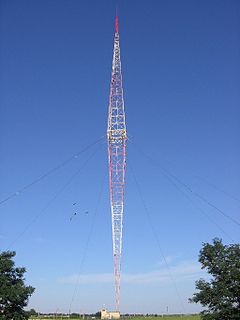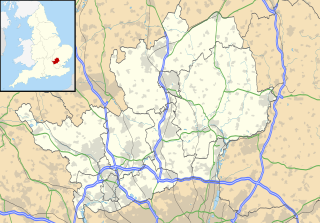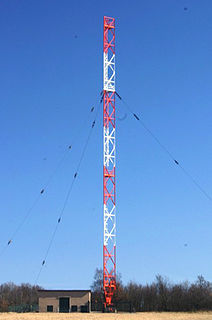
Medium wave (MW) is the part of the medium frequency (MF) radio band used mainly for AM radio broadcasting. For Europe the MW band ranges from 526.5 kHz to 1606.5 kHz, using channels spaced every 9 kHz, and in North America an extended MW broadcast band ranges from 525 kHz to 1705 kHz, using 10 kHz spaced channels. The term is a historic one, dating from the early 20th century, when the radio spectrum was divided on the basis of the wavelength of the waves into long wave (LW), medium wave, and short wave (SW) radio bands.

The AM transmitter in Burg, near Magdeburg, Germany, is a huge facility for longwave and mediumwave broadcasting. Its most dominant constructions are a 324-metre guyed radio mast and two 210 metre guyed steel tube masts.

The Wachenbrunn transmitter was a large broadcasting facility for medium wave in Wachenbrunn near Themar, Thuringia, Germany, established in the 1950s. Until 1993 the main transmitter of this facility, the medium wave transmitter for 882 kHz was run with 250 kilowatts. In that year the transmission power of this transmitter, which was formerly used for transmitting the "Voice of DDR" and since the beginning of the 1990s for "MDR info" was reduced to 20 kilowatts.

The Skelton Transmitting Station is a radio transmitter site at grid reference NY433376 near Skelton, Cumbria, England about 5 miles (8 km) north west of Penrith, run by Babcock International and owned by the MOD. Since the Belmont Mast was shortened in 2010, the mast at Skelton has been the tallest structure in the United Kingdom.

The Lakihegy Tower is a 314-metre-high (1,031 ft) radio mast at Szigetszentmiklós-Lakihegy in Hungary. The Blaw-Knox type tower was built in 1933 and was one of Europe's tallest structures at the time of construction. It was designed to provide broadcast coverage for Hungary with a 120 kW transmitter. It was built for the purpose of transmitting the radio station "Budapest I.", which it served until 1977.

FM broadcasting is a method of radio broadcasting using frequency modulation (FM) technology. Invented in 1933 by American engineer Edwin Armstrong, wide-band FM is used worldwide to provide high-fidelity sound over broadcast radio. FM broadcasting is capable of better sound quality than AM broadcasting, the chief competing radio broadcasting technology, so it is used for most music broadcasts. Theoretically wideband AM can offer equally good sound quality, provided the reception conditions are ideal. FM radio stations use the VHF frequencies. The term "FM band" describes the frequency band in a given country which is dedicated to FM broadcasting.

The Orfordness transmitting station was a major radio broadcasting facility at Orford Ness on the Suffolk coast in the United Kingdom. It closed in May 2012 after more than 30 years of service.

The Brookmans Park transmitting station is a facility for medium wave broadcasting at Brookmans Park, Hertfordshire, north of London. The station was built by the BBC as the first of a network of regional dual transmitter stations, replacing the city based ones used previously, and this was to cover the Home Counties, London and South East. The first station, on 842 kHz, (356m) 50 kW, went into service in on 21 October 1929, the second on 1148 kHz, (261m) initially 30 kW, followed on 9 March 1930.
France Info is a radio network operated by the French public service radio broadcaster Radio France. It provides continuous live news and information.
Kossuth Rádió is the national radio station of Hungary. It was established in 1925 as Budapest I. and named after Lajos Kossuth, a Hungarian national hero, in 1849. The main Hungarian-language radio station can be heard all over Central Europe; Antenna Hungária broadcasts it with 2 MW power on 540 kHz AM from transmitter Solt and several FM stations, covering Hungary and the neighbouring countries. It is the second most popular radio station in Hungary with 1.38 million listeners daily.

Marnach transmitter was a broadcasting facility of RTL near Marnach in the commune of Munshausen, in northern Luxembourg. The Marnach transmitter was built in 1955 for improving the transmission of the English-speaking program on 1439 kHz, which was transmitted from 1951 with an omnidirectional antenna from Junglinster, to the British Isles and for a better transmission on this frequency to Germany at daytime. Therefore, it was given a directional antenna with a switchable directional characteristic pointing North-northeast towards the Rhine-Ruhr area, Germany's most populated area, and West-northwest in the direction of the UK. This antenna was implemented in form of a directional antenna consisting of three ground-fed 105-metre tall guyed mast antennas arranged in the form of an isosceles triangle with a 90 degree angle. As transmitters, two 100 kW units switched in parallel were used when it went in service in December 1955.
The following radio stations broadcast on AM frequency 216 kHz:
The following radio stations broadcast on AM frequency 162 kHz:
The following radio stations broadcast on AM frequency 153 kHz:
The following radio station broadcasts on AM frequency 189 kHz:
The following radio station broadcast on AM frequency 207 kHz:
The following radio stations broadcast on AM frequency 171 kHz:
The following radio stations broadcast on AM frequency 234 kHz:










